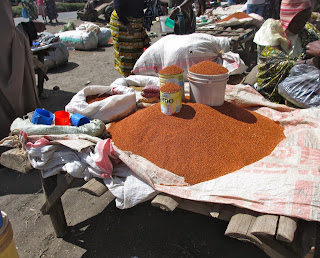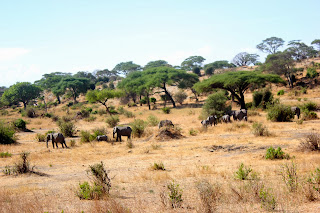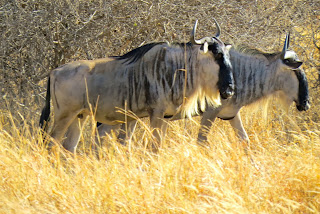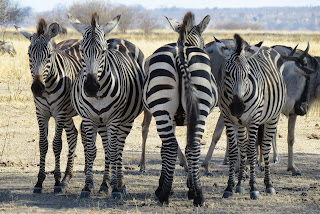We wake up to “monkey talk’, a clamorous yet charming
African alarm clock.
For the first time we climb into the Land Rovers that will
be our method of transport for the rest of the trip. The group splits up into
three vehicles; Stanley, nicknamed Zulu, drives ours. He’s an ex kick boxer,
once known as the Tyson of Tanzania who aspires to be a farmer. He’s purchased
56 acres and will grow pineapple, cabbage, avocado for a cosmetics company, and
timber for electric poles when he retires from guiding. He was born under a
shining star, the Angel Gabriel star, and he’s a great representative of the
angelic spirit, filled with kindness and good humor.
 |
| Our Chariots Await |
 |
| Stanley |
Today is a public day, a holiday commemorating the death of
the first president of Tanzania, Julius Nyerere. It is also market day.
The market is a
kaleidoscope of colors, people in motion, aromas and creative displays. Fruits
and vegetables are carefully arranged in pyramids on colorful cloths spread on
the ground. Fresh watermelon is sold from a stand. Lentils in four colors,
spices, and tiny salty dried anchovies in mounds await customers. Shelling peas
and local spinach alternate with clothing, shoes, trinkets, and chunks of charcoal.
Live chickens are caged under woven bamboo baskets and are sold according to
weight. A chicken is lifted at arm’s length and its heft determines its price.
You can have it killed at point of purchase, or take it home and kill it
yourself. A boy pedals by on his bike with a live chicken tucked under his arm,
its feet tied together with twine.
Jeans sell for 3 to 5
dollars a pair. Highly inventive “baskets” made from corrugated cardboard pieces
stapled around a circular base serve as receptacles for merchandise. Sorghum
can be purchased and mixed with fermented bananas to make an alcoholic beverage
that remains viable for only one day.
Wooden pushcarts and
wooden slatted crates help move inventory into the market.
Men sit at ancient treadle
sewing machines, doing on the spot tailoring. Others unload trucks filled with
bales of compressed clothing.
 |
| Charcoal |
 |
| Treadle Tailoring |
 |
| Clever Cardboard Container |
 |
| Fresh Produce and Salty Anchovies |
 |
| Lentils |
 |
| Fresh Watermelon Slices Sold Here |
Back in the vehicle we
stop at a duka la madawa (pharmacy) for one of our group. And it’s a convenient
place to procure a stash of Diet Coke.
We spend more time at
the Cultural Heritage Center. The complex includes restaurants, shops, and outdoor displays. It’s easy to get sucked into the gift shop, which
is in the first building we encounter, but we skirt it and find the museum. It’s
filled with gorgeous artwork, masks, carvings and paintings. One Makonde
carving is intricately cut interlocking figures all shaped from a single piece
of ebony.
 |
| Cultural Heritage Center |
 |
| Museum Interior |
 |
| Makonde Sculpture |
 |
| Outdoor Seating |
 |
| Whimsical Fountain |
We have a long drive to
Tarangire National Park.
The road is paved, but
under construction, so there are many “diversions” or detours onto bumpy
dirt-surfaced side roads. We experience
our first “African massage”, as we bounce, vibrate, jiggle and jerk. The
ceilings of the Land Rovers are padded and we are finding out why. We slide the
windows open for fresh air, and close them again when passing vehicles raise
dust. A road sign declares: “Caution Beware of Bumps” Prophetic!
 |
| Mount Meru |
Stanley is occupied
with commandeering the Land Rover through the ruts and potholes but he adds to
our background knowledge with snippets of information when he can.
· Swanglish is a
combination of Swahili and English.
· 25-30% of the land in
Tanzania is protected in parks, hunting preserves and conservation areas.
· 47 million people live
in Tanzania.
· The rainy season is in
May. There are short rains in November and December.
· Women and men from
different tribes make up a British style parliament. There is no fighting among
tribes. They are working towards blending into one Tanzania.
There is nothing much
appealing about this landscape. This land is thirsty, dry, dry, dry. Herds of goats, sheep and long horned cattle
and an occasional burro keep us entertained. The animals find scraps of shade
under a rare tree and huddle there. Dust devils spin and whirl. A solitary
woman walks with a bundle of firewood balanced on her head.
 |
| Cattle Crossing |
 |
| The Wealth of the Masai |
The round thatched huts
that make up Masai villages appear and disappear as we whiz by. Small boys, as
young as seven, tend the cattle, carrying just a stick. Round corrals are
constructed with walls of brush and sticks. For the Masai their cows are their
wealth. Each animal is worth $400 -$600.
We see short plank boxes hanging from tree limbs and are told they are beehives. Lumpy, bumpy off kilter earthen mounds riddled with holes are often the landscape’s only structure. They are home to termite colonies and they rise to a height of several feet. As we near Tarangire Park bits of green start to appear here and there in the terrain.
 |
| Termite Mound 1 |
 |
| Termite Mound 2 |
Just before we
officially enter the park we stop at a picnic area. We packed box lunches this
morning with chicken sandwiches, raw vegetables, cookies and a bar of
chocolate. The chocolate has liquefied in the heat.
The monkeys watch us
eat.
 |
| Lunch in Tarangire |
The pervasive presence
of the tsetse fly caused the people who once inhabited this area to move out.
The government traded for the land they occupied and created this park of 1100
square miles in 1970. This is a rare instance of gratitude that can be directed
towards the tsetse fly, (a nasty biting bug that transmits sleeping sickness).
We stand with our toes
on the threshold of “animal planet”, ready for our first real game viewing
drive. The area we are about to enter is not the accustomed way we have viewed
these animals, in enclosures, in zoos, but instead, the authentic home to thousands of
creatures living in a complex interdependency. We intrude, but benevolently.
Each and every encounter from the tiniest iridescent bird to the enormous
elephants is a thrill as we accustom ourselves to the reality of this
biosphere.
The biggest rush of the
day occurs when an elephant herd surrounds our vehicles, coming so close we
could (but don’t) touch them. They treat us like scenery and continue feeding
on brushy leaves, scratching themselves on tree trunks and guiding their tiny
(by comparison) offspring and keeping them close. The roof of the Land Rover is
popped up and we stand on the seats for unobstructed views and photos.
· Impala
browsing and grazing. They can spring 10 feet in the air and leap 15 feet.
Many giraffes, but one
particular group of five sitting together all facing outwards, each in a different
direction, a defensive tactic we will see other animals use. The giraffe we’re seeing is the Masai giraffe.
Its coloration is a little darker than the Rothschild giraffe that is seen most
often in our zoos. Also seen in Africa, are the Reticulated giraffe and the
Kapi. By the way, they have the largest heart of any mammal. Think of how hard
that heart has to work against gravity to circulate blood all the way to that
brain, way way up there.
 |
| Masai Giraffe |
 |
| Beautiful Peaceful Creature |
 |
| Keeping an Eye on Things |
· Superb Starling
· White Headed Buffalo
Weaver
· Lilac Breasted Roller
· Egyptian Eagle
· The first herds of the
zillions of Zebra we’ll encounter. Each zebra has its own pattern, just like
snowflakes. We’re seeing the common, (or Plains), zebra which has wider stripes
than the mountain zebra, (found along the southern tip of the continent).
Before zebras fully mature, their stripes are brown.
- Water Buck
- Banded Mongoose
The baobab trees and elephants are the icons of this park. Each represents longevity.
The elephant can live 65 to 70 years. The baobab, nicknamed “the upside-down tree” looks like it has been planted on its head with gnarly roots sticking up into the air. The tree can live to be 3000 years old. In the dry season, (now), it is leafless, its dark wiry branches stark against the sky. It bears a globe-like fruit that has medicinal qualities.
 |
| Baobab |
Other iconic trees of
Africa are the Acacia, or Thorn Tree, the Sausage Tree, named because of its
long tapered fruit, its bark is used against typhoid, and the Candelabra Tree, (Euphorbia) whose limbs spring skyward directly from the middle of the
trunk supporting succulent green growth.
 |
| Candelabra Tree |
 |
| Sausage Tree |
 |
| Tarangire River in the Dry Season |
Poaching is a
staggering problem. An elephant is lost every 15 minutes in Africa and the black
rhinoceros is endangered. Somali people dress as Masai and arm themselves with
AK47s. They have almost wiped out the rhinoceros and cut into the elephant
population. Poachers use the cavities and hollows of the huge baobab trees to
hide themselves and to store their trophies. They sometimes grind the ivory
into powder to get it past customs. Once it’s out of the country they
reconstitute it and compress it.
Park rangers live on
site with their families and patrol at night. They also carry AK47s. If they catch poachers
in the park, they kill them.
Our lodging tonight is
the Lake Burungi Tented Camp. This is a permanent camp, with views of the lake
in the distance and Tarangire National Park beyond.
Chobani greets us with
cold sweet tea in small glasses and a tray of cool, damp, rolled washcloths.
He invites us to “drink as much as you can”, (because there is a minimum charge
to use a credit card). He reminds us to “remember the combination to your room
safe, otherwise I will be lucky.” His humor continues when he tells us he will
“give you a whistle with your room key. If you find a lion in your room, blow
the whistle as much as you want.”
 |
| Lake Burangi |
 |
| Lake Burangi Lodge |
 |
| "Tent" Interior |
 |
| Bathroom |
 |
| Solar Panels Provide Hot Water and Lights |
Dinner by candlelight on the expansive deck underneath umbrellas. An oversized bottle of Tusker beer washes down the dust.
 |
| Dinner on the Deck |


















































Anna says: "I love the giraffe !! whats a
ReplyDeletekick boxer? i love your room! It is so asawm
I miss you nana
and braukaw
:) (heart) :) ^^
Sean: "That's an amazing trip! I want to go on a trip like that one day. (Anna says "me too") Nana is an incredible writer!"
xox
Submit your blog to the tour company. Customers will quadruple after reading this and seeing all of your pictures. I feel so entertained and educated!!
ReplyDeleteAfrica comes to life in your story telling. I'd be curios to know more about the justice system as it sounds like crimes are punished on the spot.
ReplyDelete